Table of Contents
Introduction: Class 12 Chemistry 2013 Outside Delhi
CBSE Previous Year Question Papers Class 12 Chemistry 2013 Outside Delhi
Time allowed: 3 hours
Maximum Marks: 70
CBSE Previous Year Question Papers Class 12 Chemistry 2013 Outside Delhi Set I
Question 1.
Of physisorption or chemisorption, which has a higher enthalpy of adsorption? [1]
Answer:
Chemisorption.
Question 2.
Name the method used for refining of copper metal. [1]
Answer:
Electrolytic refining of copper metal.
Question 3.
Name two poisonous gases which can be prepared from chlorine gas. [1]
Answer:
Chloropicrin or tear gas (CCl3NO2) and phosgene gas (COCl2).
Question 4.
Write the IUPAC name of the following compound: [1]
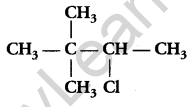
Answer:
2-chloro-3, 3-dimethyl butane.
Question 5.
Rearrange the following compounds in the increasing order of their boiling points: [1]
CH3-CHO, CH3-CH2-OH2, CH3 – CH2 – CH3
Answer:
CH3CH2CH3 < CH3CHO < CH3CH2OH
Question 6.
Write the structure of N-methylethanmine. [1]
Answer:

Question 7.
What are the products of hydrolysis of sugar? [1]
Answer:
Glucose and fructose.
Question 8.

Answer:
Homopolymer.
Question 9.
Account for the following: [2]
(i) Schottky defects lower the density of related solids.
(ii) The conductivity of silicon increases on doping it with phosphorus.
Question 10.
Aluminium crystallizes in an FCC structure. The atomic radius of the metal is 125 pm, what is the length of the side of the unit cell of the metal? [2]
Question 11.
The standard electrode potential (E°) for Daniell cell is +1.1 V. Calculate ∆G° for the reaction: [2]
Zn (s) + Cu2+(aq) → Zn2+(aq) + Cu(s)
(1F = 96500 C/mol)
Answer:
n = 2, E°cell =1.1 volt, 1F = 96500 C mol-1
∆rG° = -nFE°cell
= -2 × 96500 × 1.1
= -212.3 kJ mol-1
Question 12.
For a reaction A + B → P, the rate law is given by [2]
r = k [A]1/2 [B]2
(a) What is the order of this reaction?
(b) A first-order reaction is found to have a rate constant k = 5.5 x 10-14 s-1. Find the half life of the reaction.
Answer:
(a) Order of reaction = \(\frac { 1 }{ 2 }\) + 2 = \(\frac { 5 }{ 2 }\)
(b) For first order reaction,
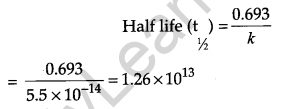
Question 13.
(a) Name the method used for removing gangue from sulphide ores. [2]
(b) How is wrought iron different from steel?
Answer:
(a) Froth floatation method.
(b) Wrought iron is the purest form of iron with 0.2-0.5% carbon and steel is an alloy of iron. Wrought iron is produced from cast iron. Steel is an alloy of iron and other elements. It has a carbon content of 0.1-1.5%. They also have different properties, industrial and decorative applications.
Question 14.
Draw the structures of the following molecules:
(i) XeOF4
(ii) H3PO3 [2]
Answer:
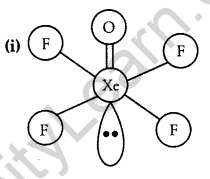
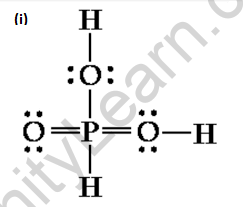
Question 15.
How are interhalogen compounds formed? What general compositions can be assigned to them? [2]
Answer:
Interhalogen compounds are formed by direct combination of halogens or by the reaction of halogen on lower interhalogen compounds. The general composition of interhalogen compounds are:
XX’, XX’3 XX’5, XX’7
Question 16.
Explain the mechanism of the following reaction: [2]
![]()
Answer:
Mechanism: It involves three steps
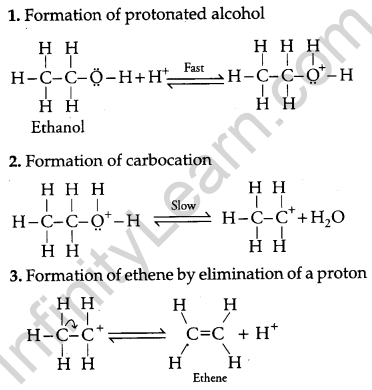
Question 17.
Write the equations involved in the following reactions: [2]
(i) Reimer-Tiemann reaction
(ii) Williamson ether synthesis
Answer:
(i)
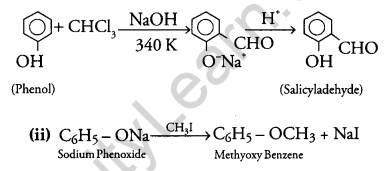
Question 18.
Define thermoplastic and thermosetting polymers. Give one example of each. [2]
OR
What is a biodegradable polymer? Give an example of biodegradable aliphatic polyester.
Answer:
Thermoplastic Polymers: They are plastics which becomes soft on heating and can be remoulded. They have fewer forces e.g. Polythene.
Thermosetting Polymers: They do not become soft on heating and cannot be remoulded. They have a strong force of attraction e.g. bakelite.
OR
Natural polymers such as starch and cellulose that naturally disintegrate themselves, over a period of time are called biodegradable polymers. Example of biodegradable aliphatic polyester is PHBV (Poly-β-hydroxybutyrate-co-β-hydroxy Valerate).
Question 19.
The rate of a reaction becomes four times when the temperature changes from 293 K to 313 K. Calculate the energy of activation (Ea) of the reaction assuming that it does not change with temperature. [3]
[R = 8.314 J/K mol-1, log 4 = 0.6021
Answer:
Given,
T1 = 293K, T2 = 313 K.
R = 8.314 JK-1 Mol-1
log 4 = 0.6021

Question 20.
What are the characteristics of the following colloids? Give one example of each. [3]
(i) Multimolecular colloids
(ii) Lyophobic sols
(iii) Emulsions.
Answer:
(i) On dissolution, a large number of atoms or molecules of a substance aggregate to form colloidal particles. This colloid is called a multimolecular colloid, e.g. Sulphur sol.
(ii) The colloids in which there is no affinity between the particles of dispersed phase and dispersion medium are called lyophobic colloids. They are not stable, that is easily coagulated and irreversible. They are produced only by special methods, eg. AS2S3 sol, Fe(OH)3 sol.
(iii) Emulsions are colloids in which both dispersed phase and dispersing medium are liquid and immiscible with each other eg. Milk, cod liver oil, etc.
Question 21.
Give reasons for the following: [3]
(i) When R is an alkyl group R3P = 0 exist but R3N = 0 doesn’t.
(ii) PbCl4 is more covalent than PbCl2.
(iii) N2 is much less reactive at room temperature.
Answer:
(i) Due to the absence of d-orbitals, N cannot form pπ-dπ multiple bonds. Thus, it cannot expand its covalency beyond 4. In R3N = 0, N has covalency 5 so it does not exist. On the other hand, due to the presence of d-orbitals, P forms pπ-dπ multiple bonds and expand its covalency beyond 4. In R3P = 0 covalency of P is 5 hence it exists.
(ii) Because ‘Pb’ is in +4 oxidation state in PbCl4 and has high charge/size ratio than Pb2+. According to Fazan’s rule, a higher charge on cation or anion makes compound more covalent, +4 state is more stable than +2 state. Hence PbCl4 is more covalent than PbCl2
Question 22.
For the complex [NiCl4]2-, write [3]
(i) the IUPAC name
(ii) the hybridization type
(iii) the shape of the complex (Atomic no. of Ni = 28)
OR
‘What is meant by crystal field splitting energy? On the basis of crystal field theory, write the electronic configuration of d4 in terms of t2g and eg in an octahedral field when
(i) ∆0 > P
(ii) ∆0 < P
Answer:
(i) Tetrachloridonickelate (II) ion
(ii) sp3 hybridisation
(iii) Tetrahedral shape.
OR
In octahedral complexes, the d-orbitals split into two sets, one with two orbitals of high energy (t2g) and three orbitals with lower energy (eg). The difference in energy levels of these sets is the crystal field splitting energy.
(i) When ∆0 > P, an electronic configuration is t2g4 eg0


(ii) When ∆0 < P, electronic configuration is t32ge1g

Question 23.
Give reasons for the following:
(i) Ethyl iodide undergoes SN2 reaction faster than ethyl bromide.
(ii) (±) 2-Butanol is optically inactive.
(iii) C-X bond length in halobenzene is smaller than C-X bond length in CH3-X.
Answer:
(i) I– ion is better-leaving group than Br– ion, therefore, ethyl iodide reacts faster than ethyl bromide in an SN2 reaction.
(ii) (+) 2-butanol is optically inactive because it is racemic mixture i.e. it has enantiomers in equal amount and hence they cancel each other’s rotation of plane polarised light.
(iii) In halobenzene, the halogen atom is attached to sp3 hybridized carbon while in CH3-X sp2 hybridized carbon which is smaller in size than sp3 hybridized carbon attached to the halogen. Therefore C-X bond in halobenzene is shorter than in CH3-X.
Question 24.
Complete the following reactions: [3]
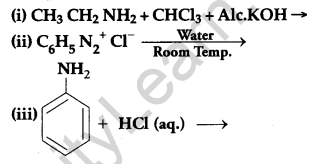
Answer:

Question 25.
(i) What class of drug is Ranitidine? [3]
(ii) If the water contains dissolved Ca2+ ions, out of soaps and synthetic detergents, which will you use for cleaning clothes?
(iii) Which of the following is an antiseptic?
0.2% phenol, 1% phenol
Answer:
(i) Antacid.
(ii) Soap gets precipitated in hard water hence it can’t be used to wash clothes. On the other hand, synthetic detergents do not precipitate in hard water because its calcium salt is soluble in water. Therefore, it can be used to wash clothes in hard water.
(iii) 0.2% phenol.
Question 26.
Calculate the emf of the following cell at 25°C: [3]
Ag(s) | Ag+(10-3M) || Cu2+(10-1M) | Cu(s)
Given Ecell° = +0.46V & log10n = n.
Given cell notation is incorrect correct cell formula is
Cu2+ (10-1M) | Cu(s) || Ag+(10-3M) | Ag(s)
Answer:
According to Nernst equation,
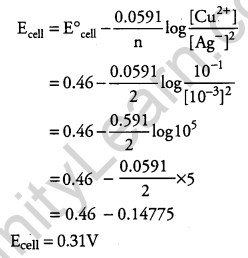
Question 27.
Shanti, a domestic helper of Mrs Anuradha, fainted while mopping the floor. Mrs Anuradha immediately took her to the nearby hospital where she was diagnosed to be severely ‘anaemic’. The doctor prescribed an iron rich diet and multivitamins supplement to her. Mrs Anuradha supported her financially to get the medicines. After a month, Shanti was diagnosed to be normal.
(i) What values are displayed by Mrs Anuradha?
(ii) Name the vitamin whose deficiency causes ‘pernicious anaemia’. [3]
(iii) Give an example of a water-soluble vitamin.
Answer:
(ii) Pernicious anaemia is caused due to deficiency of Vitamin B12.
(iii) Vitamin C and Vitamin B.
Question 28.
(a) State Raoult’s law for a solution containing volatile components. How does Raoult’s law become a special case of Henry’s law?
(b) 1.00 g of a non-electrolyte solute dissolved in 50 g of benzene lowered the freezing point of benzene by 0.40 K. Find the molar mass of the solute. (Kf for benzene = 5.12 K kg/ mol) [5]
OR
(a) Define the following terms:
(i) Ideal solution
(ii) Azeotrope
(iii) Osmotic pressure.
(b) A solution of glucose (C6H12O6) in water is labelled as 10% by weight. What would be the molality of the solution?
(Molar mass of glucose = 180 g/mol)
Answer:
(a) Raoult’s law states that the partial pressure of a vapour of a component in the solution is directly proportional to its mole fraction in the solution.
Raoult’s law becomes a special case of Henry’s law as it states that the partial pressure of a gas in the vapour phase is directly proportional to the mole fraction of the gas in the solution.

OR
(a) (i) A solution that obeys Raoult’s law overall ranges of temperature and concentration and shows no attractive forces between components, is called an ideal solution.
(ii) A liquid mixture which distils at a constant temperature without undergoing any change in its composition is called Azeotropes.
(iii) The minimum external pressure required to prevent osmosis is known as osmotic pressure.
(b) Given:
Molecular Mass of Glucose (MB) = 180
% by wt. = (WB) = 10
Molality (m) = ?
We know
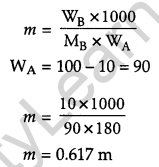
Question 29.
(a) Give reasons for the following: [5]
(i) Mn3+ is a good oxidising agent.
(ii) E°M2+/M values are not regular for first-row transition metals (3d series).
(iii) Although ‘F’ is more electronegative than ‘O’, the highest Mn fluoride is MnF4, whereas the highest oxide is Mn2O7.
(b) Complete the following equations:
![]()
OR
(a) Why do transition elements show variable oxidation states?
(i) Name the element showing the maximum number of oxidation states among the first series of transition metals from Sc (Z = 21) to Zn (Z = 30).
(ii) Name the element which shows only +3 oxidation state.
(b) What is lanthanoid contraction? Name an important alloy which contains some of the lanthanoid metals.
Answer:
(i) Mn+3 has electronic configuration 3d4 40. It gains one electron on reduction and become 3d540 which is a half-filled stable configuration. Hence it is a good oxidizing agent.
(ii) Due to extra stability of half and fully filled d-orbitals and variations in ionization energies E0M2+/M values are not regular.
(iii) Due to the ability of oxygen to form multiple bonds with metals and because oxygen stabilizes the highest oxidation state even more than fluorine.

OR
(a) Due to the presence of incompleted d-orbitals, transition elements show variable oxidation states.
(i) Manganese shows oxidation states from +2 to +7.
(ii) Scandium (Sc).
(b) Lanthanide contraction refers to the steady and regular decrease in atomic size along the period from La3+ to Lu3+ eg. Misch metal alloy which contains 95% lanthanoids and 5% iron.
Question 30.
(a) How will you convert the following: [5]
(i) Propanone to Propan-2-ol
(ii) Ethanal to 2-hydroxy propanoic acid
(iii) Toluene to benzoic acid
(b) Give a simple chemical test to distinguish between:
(i) Pentan-2 -one and Pentan-3 -one
(ii) Ethanal and Propanal
OR
(a) Write the products of the following reactions:

(b) Which acid of each pair shown here would you expect to be stronger?
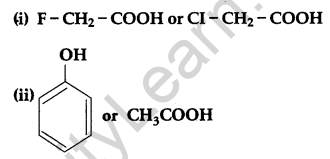
Answer:
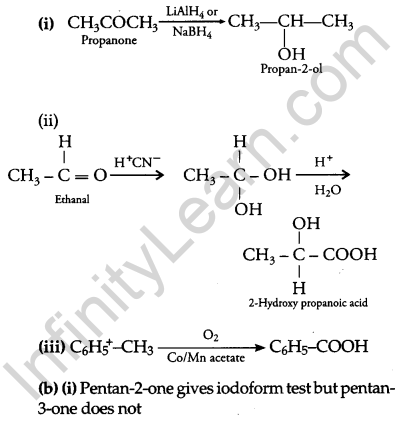
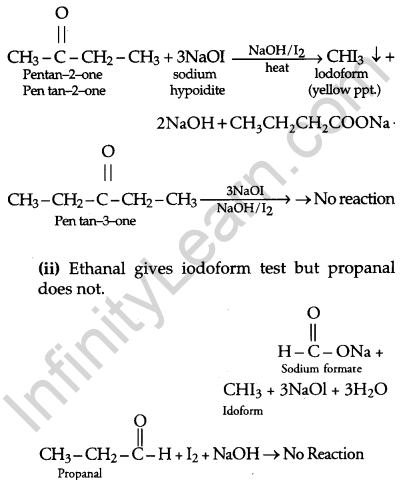
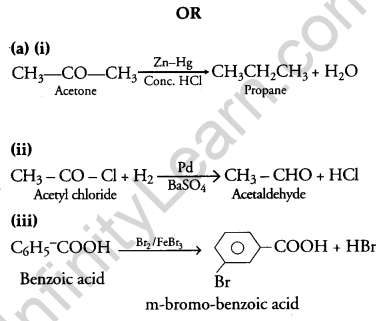
(b) (i) F-CH2-COOH is a stronger add than Cl-CH2-COOH because F is more electronegative than Cl, so it will favour the release of H+ ion faster by dragging electron density towards itself more as compared to Cl.
(ii) Acetic acid CH3COOH is a stronger acid than phenol. Acetic acid forms carboxylate ion and phenol forms phenoxide ion. Carboxylate ion is more stable than phenoxide ion due to resonance.
CBSE Previous Year Question Papers Class 12 Chemistry 2013 Outside Delhi Set II
Note: Except for the following questions, all the remaining questions have been asked in the previous set.
Question 1.
Write the structure of 2-amino toluene. [1]
Answer:
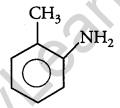
Question 2.
Which aerosol depletes ozone layer? [1]
Answer:
Chlorofluorocarbons (CFCs) present in aerosols depletes the ozone layer.
Also Get: PDF’s of Sample Question Paper from CBSE Official website
Question 4.
Ethanal is soluble in water. Why? [1]
Answer:
Ethanal is soluble in water due to Hydrogen bonding.
Question 5.
Write the IUPAC name of the following compound: [1]

Answer:
2-Bromo-4-chloropentane.
Question 7.
Write the name of the linkage joining two amino acids. [1]
Answer:
Peptide linkage.
Question 8.
Give one example of a condensation polymer. [1]
Answer:
Dacron or Nylon-6, 6.
Question 9.
(a) Why does the presence of an excess of lithium make LiCl crystals pink? [2]
(b) A solid with cubic crystal is made of two elements P and Q Atoms of Q are at the comers of the cube and P at the body-centre. What is the formula of the compound?
Question 14.
Draw the structures of the following molecules: [2]
(i) XeF6
(ii) H2S2O7
Answer:
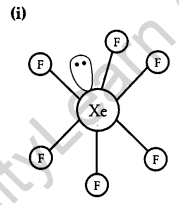
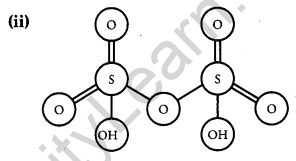
Question 18.
Outline the principles of refining of metals by the following methods: [2]
- Zone refining
- Vapour phase refining
Answer:
- This method is based on the principle that the impurities are more soluble in the molten state than in the solid-state of the metal.
- In this process, the metal is converted to its volatile compound, collected elsewhere and then decomposed to give pure metal.
Question 19.
Define the following terms giving an example of each: [2]
(i) Associated colloids
(ii) Lyophilic sol
(iii) Adsorption.
Answer:
(i) Associated colloids are colloidal substances which at low concentrations behave as normal electrolytes but at higher concentration, they aggregate to form colloids, eg. Soaps and detergents.
(ii) Lyophilic sols are the colloids in which the particles of dispersed phase have a strong affinity for the dispersion medium. They are reversible in nature because on precipitation they can be easily converted back to colloidal form by adding dispersion medium, eg. Starch sol.
(iii) The aggregation of a substance on the surface of a liquid or solid is known as adsorption eg. Adsorption of poisonous gases on charcoal.
Question 22.
Write the main products of the following reactions: [2]
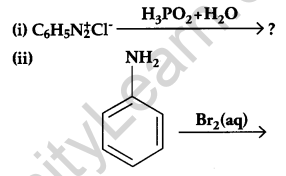
Answer:


Question 27.
Give reasons for the following: [3]
(i) Oxygen is gas but sulphur is solid.
(ii) O3 acts as a powerful oxidising agent.
(iii) BiH3 is the strongest reducing agent amongst all the hydrides of Group 15 elements.
Answer:
(i) Oxygen is smaller in size than sulphur. Due to small size, it can effectively form pπ-pπ bonds and forms diatomic O2 molecule. The intermolecular forces in oxygen are weak van der Waals forces, which causes it to exists as a gas. On the other hand, sulphur does not form strong S=S double bonds and exists as a puckered structure held together by covalent bonds and exists as a polyatomic molecule. So, it exists as solid.
(ii) O3 act as a powerful oxidising agent because it decomposes to give nascent oxygen.
CBSE Previous Year Question Papers Class 12 Chemistry 2013 Outside Delhi Set III
Note: Except for the following questions, all the remaining questions have been asked in previous sets.
Question 1.
What is especially observed when a beam of light is passed through a colloidal solution? [1]
Answer:
Tyndall effect is observed due to the scattering of light.
Question 2.
What is the basicity of H3PO3 and why? [1]
Question 3.
Write the IUPAC name of the following compound: [1]

Answer:
2,4-dichlorotoluene
Question 8.
Write the structure of prop-2-en-l-amine. [1]
Answer:
H2C = CH – CH2 – NH2
Question 12.
Draw the structures of the following molecules:
(i) N2O5
(ii) XeF2 [2]
Answer:
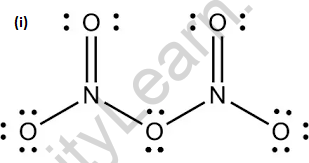
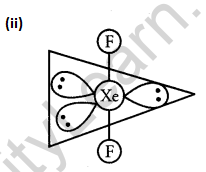
Question 13.
(a) What change occurs when AgCl is doped with CdCl2?
(b) What type of semiconductor is produced when silicon is doped with boron? [2]
Question 18.
Name the principal ore of aluminium. Explain the significance of leaching in extraction as aluminium. [2]
Answer:
Bauxite (Al2O3.2H2O) is the principal ore of aluminium. The significance of leaching in the extraction of aluminium is to prepare pure alumina from the bauxite ore in the following steps:

After filtration of impurities, sodium meta aluminate is neutralized by passing CO2.

Question 19.
Define the following terms with an example in each case: [3]
(i) Macromolecular Sol
(ii) Peptization
(iii) Emulsion.
Answer:
(i) Macromolecular sol: They are molecules of large size having high molecular masses. Due to the long chain, the van der Waals forces are stronger. Eg. rubber, nylon, etc.
(ii) Peptization: It is the process of converting a precipitate into colloidal solution by shaking it with dispersion medium in the presence of a small amount of electrolyte. E.g. A precipitate of Agl can be peptized by shaking with a dilute
solution of silver nitrate.
(iii) Emulsion: A type of colloidal solution in which both the dispersed phase and dispersion medium are liquid and are immiscible with each other is called emulsion. Ex. milk.
Question 21.
Give reasons for the following: [3]
(i) Though nitrogen exhibits a +5 oxidation state, it does not form pentahalide.
(ii) Electron gain enthalpy with a negative sign of fluorine is less than that of chlorine.
(iii) The two oxygen-oxygen bond lengths in ozone molecules are identical.
Answer:
(ii) Due to small size, fluorine atom has high electronegativity and strong electron-electron repulsions in its compact 2p orbitals, its electron gain enthalpy is less than that of chlorine.
(iii) The two oxygen bond lengths in ozone are identical due to resonance.






